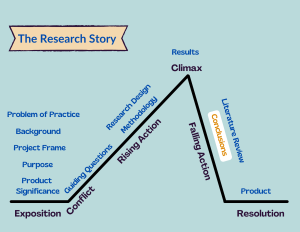Capstone Components
16 Conclusions
The story continues…
The next morning, as Harry and Physicus finished the last cold slice of George’s pizza, they had also finished collecting their literature to conduct a review. The friends concluded their theory about the number of mice influencing Pickles’ behavior had considerable support in the research literature.
Physicus inquired, “What would you conclude based on our findings and the literature review, Harry?”
“Well,” Harry replied, “our results showed that Pickles will catch mice, but apparently he feels overwhelmed by too many mice in my house. Well, Pickles is not alone. I feel overwhelmed too!”
“Okay,” Physicus agreed, “what evidence supported these conclusions?”
Harry replied. “When the count of mice is less than four, Pickles gets them every time and quickly! If Pickles is hungry he will even attack four mice. We also found support in the research literature for this finding.”
“Great,” said Physicus, his face shining with happiness.
“I think we can find a way to limit the number of mice Pickles encounters, then he will attack,” said Harry, “What do you think?”
Physicus exclaimed, “I’m sure we can do this! But first, Harry, what else did we learn?”
“Well, we learned that if there are five or more mice in the room, Pickles did not attack. This supports the conclusion that he becomes overwhelmed by the number of mice.”
“On the money, Harry,” Physicus said and gave Harry a high-five! Physicus continued, “I agree, Pickles becomes overwhelmed and unmotivated to catch more than three mice at a time. These are important conclusions that other cat owners would like to know!”
“We also learned about several ways we can limit the number of mice a cat encounters in our literature review,” said Harry.
“Awesome!” exclaimed Physicus, “How do we share this information, Harry?”
Harry shrugged his shoulders and said, “I do not know, Physicus. What do you suggest?”
“Well,” Physicus replied, “we can look into submitting an article to a research journal.”
“This sounds amazing, but first can we get rid of the mice in my house?” asked Harry.
Physicus and Harry set to work on a plan to get rid of all the mice in Harry’s house.
Interpreting the Story
The friends reviewed their findings and discussed their conclusions. Based on their research they concluded that Pickles did indeed become overwhelmed by exposure to too many mice at once. The friends found the maximum number of mice Pickles would attack. This conclusion provided a clear solution to solve Harry’s problem. The friends simply needed to limit the number of mice in the room and Pickles would catch them all. As the friends discovered, cats can become overwhelmed by the number of mice encountered. The friends also learned about several strategies they could employ to limit the mice encountered by the cat.
Conclusions
The Conclusions heading presents assertions and suppositions about the findings of the research project. The heading details the claims the researcher makes based on the findings. The claims are supported by the findings of the project and by previously published research from your Literature Review. The heading reads similar to a persuasive work in that there is a presentation of an assertion and an argument detailing the reasoning to support the assertion.
The Conclusion is written to explain the relationship between the specific findings of your research and the purpose of the project. The heading presents your suppositions made about the results. These suppositions emphasize what was learned in the research project and how the results will be incorporated into the product. The writing argues how the findings demonstrate the value of the research project and how it supports the product development.
telling the research story
The Conclusions heading is the falling action leading to the resolution of the research story. The heading explains “what we now know.” This part of the story argues the value of what was found and makes claims about the knowledge that was acquired from the quest. The writing tells what the climax means for the characters in the story and how “what we now know” influences the product. The Conclusions heading is in Chapter 2 of a capstone project.


